WHAT'S NEW ACROSS THE WORLD
| What's New ©by
Laif DeMason
Summer is now gone, but the spiraling increases
in gasoline prices remain. Petroleum products around the world now cost
substantially more, thus effecting prices of other products, as well as
other aspects of our lives. The costs of tropical fish collection, styrofoam
boxes, and the associated shipping freight have, accordingly, slowly risen.
For now most importers and wholesalers have absorbed much of these steady
increases. However, dealers cannot be expected to do this for long. Many
retail stores and small local jobbers have decided to buy direct, thus
cutting out the normal importers and wholesalers; while the prices can
be low, the handling and care in small facilities may not match in quality.
Further, some cichlid dealers are willing to sell directly to hobbyists
on internet auction sites, causing larger importers to drop several lines
of cichlids due to lack of interest. Cichlid hobbyists are still enjoying
historically low prices, but the full effects of this “streamlining” with
marketing and sales has yet to be seen.
Here’s “what’s new” on the cichlid scene: |
Lake Tanganyika
Wild-collected cichlids from all corners of Lake Tanganyika are available
in good supply. Even collections in Congo have become almost “normal,”
with at least four export companies actively collecting there. Thus, many
of the species not seen in the hobby for over ten years have recently become
available again. Hopefully we will start seeing some completely novel items
from Congo collections sometime soon! Bred items are still plentiful and
popular with cichlid hobbyists on a budget.
|
what's new: Lake Tanganyika
|

Collected in northern Congo, Cyprichromis microlepidotus
Kabembe sports yellow body hues along with violet finnage. |

Originally from southern Congo, Neolamprologus
nigriventris is infrequently available from breeders. |
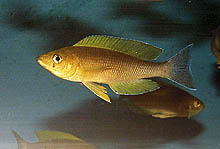
A solid yellow male Cyprichromis leptosoma
Jumbo from Mbita Island, Zambia. |
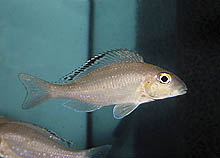
Xenotilapia spilopterus from Nsumbu, Zambia
sports a black dorsal fin line rather than the usual oblong spot. |
Lake Malawi
Several novel items have appeared in recent shipments of wild cichlids
from Malawi. As the four or five Tanzanian cichlid export companies continue
to harvest at most points around the lake, regardless of country, Malawi
exporters are forced to “dig up” something a little different to attract
more sales. Importers and hobbyists alike seem to enjoy a change of pace
from time to time. Florida cichlid farms and other breeders have their
full production for this season in hand now; thus, selection is good.

Occasionally seen and collected, this yellowish “marmalade
cat” (i.e., OB male) Labeotropheus fuelleborni is from Katale Island,
Malawi. |

Found in Monkey Bay, Malawi, a new peacock formerly
known as “yellow collar,” Aulonocara sp. Msasa. Photo by A. Konings. |

Newly exported from Chitande Island, Malawi, Aulonocara
stuartgranti is similar to the Chilumba variety, but is typically much
larger. Photo by A. Konings. |

Exported more than once in the past (with incorrect
females), Aulonocara sp. chitande-type “yellow head” is found in
deep waters around Nkhata Bay, Malawi. Photo by A. Konings. |
Lake Victoria / Madagascar
Lake Victoria cichlid fans are eager for new items, but still endure
the long dry spell since the last exports of wild material nearly ten years
ago. The explosion of new species imported during the late eighties to
the mid-nineties has long since stopped. Bred material is the only fare
available now. Many of the cichlid species from the Tanzanian shores of
Lake Victoria (and studied by the Dutch biologists) have also been incorporated
into the hobby by breeders for some time now. Hobbyists eagerly await any
news of new activity. Unfortunately, I have none to report at this time.
West Africa
Many cichlid hobbyists are trying their hand at the new flush of species
from the exporting countries of West Africa. Many species are much smaller
and require specialized water chemistry, creating a good challenge for
cichlid fans that are keen on breeding. Unfortunately, most species are
not yet widely-available from bred sources; hopefully, this situation will
soon change. In the mean time, wild-caught items are seasonally available.

ERRATUM: Pictured in April 2005 as Thysochromis
ansorgii, this fish is actually Pelmatochromis nigrofasciatus
from the DR Congo; pictured here again! |

Rarely imported from Guinea, Tilapia brevimanus
can grow to a fairly large size in the aquarium. |
Neotropics
Cichlids from the Americas are available from many sources. Unlike the
newer West African species, a large number of varieties are available from
captive-raised stocks. Many dwarf “Apistos,” discus, and others cichlids
are actively offered as bred items. Of course, wild-caught items are also
regularly imported, thus making available a very wide range of Neotropical
species.

Imported regularly from Brazil, Crenicichla menezesi
(here, a female) are available in retail stores. Photo by K. Duelund. |
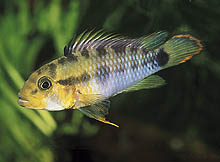
Originally from Peru, Apistogramma sp. “twin”
(here, a male) is closely related to Ap. nijsseni. Photo by U. Römer. |
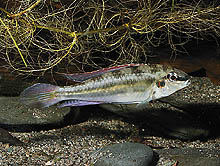
From the Rio Tapajos in Brazil, Dicrossus sp.
Itaituba is a recently-imported dwarf species. Photo by O. Lucanus. |
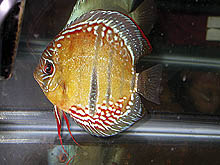
Exhibited in the recent ACA show as a wild form, this
Symphysodon discus appears similar to the Alenquer type. |
|













